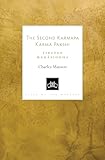The second karmapa Karma Pakshi : tibetan mahasiddha / Charles Manson.
Material type: TextPublication details: Boulder, Colorado : Shambhala, 2022.Description: x, 288 p. : 22 cmISBN:
TextPublication details: Boulder, Colorado : Shambhala, 2022.Description: x, 288 p. : 22 cmISBN: - 9781559394673
- 294.3923092 MAN
| Current library | Call number | Status | Barcode | |
|---|---|---|---|---|
| ISER Library | 294.3923092 MAN (Browse shelf(Opens below)) | Available | E20838 | |
| ISER Library | 294.3923092 MAN (Browse shelf(Opens below)) | Available | E20839 | |
| ISER Library | 294.3923092 MAN (Browse shelf(Opens below)) | Available | E20840 | |
| ISER Library | 294.3923092 MAN (Browse shelf(Opens below)) | Available | E20841 | |
| ISER Library | 294.3923092 MAN (Browse shelf(Opens below)) | Available | E20842 |
Browsing Paro College Library shelves Close shelf browser (Hides shelf browser)
| No cover image available No cover image available | No cover image available No cover image available | No cover image available No cover image available |

|

|

|

|
||
| 294.3923092 LHU རྒྱལ་སྲས་བསྟན་འཛིན་རབ་རྒྱས་ཀྱི་རྣམ་ཐར། / | 294.3923092 LHU རྒྱལ་སྲས་བསྟན་འཛིན་རབ་རྒྱས་ཀྱི་རྣམ་ཐར། / | 294.3923092 LHU རྒྱལ་སྲས་བསྟན་འཛིན་རབ་རྒྱས་ཀྱི་རྣམ་ཐར། / | 294.3923092 MAN The second karmapa Karma Pakshi : tibetan mahasiddha / | 294.3923092 MAN The second karmapa Karma Pakshi : tibetan mahasiddha / | 294.3923092 MAN The second karmapa Karma Pakshi : tibetan mahasiddha / | 294.3923092 MAN The second karmapa Karma Pakshi : tibetan mahasiddha / |
Includes index.
The life and writings of a Tibetan meditation master who became the Buddhist priest to two Mongol emperors and is recognized as one of the earliest reincarnated lamas in Tibet. Karma Pakshi is considered influential in the development of the reincarnate lama tradition, a system that led to the lineage of the Dalai Lamas. Born in East Tibet in the thirteenth century, Karma Pakshi himself was the first master to be named Karmapa, a lineage that continues to modern times and has millions of admirers worldwide. During his lifetime, Karma Pakshi was widely acknowledged as a mahāsiddha--a great spiritual adept--and was therefore invited to the Mongol court at the apogee of its influence in Asia. He gave spiritual advice and meditation instructions to the emperor Möngke Khan, whom he advised to engage in social policies, to release prisoners, and to adopt a vegetarian diet. After Möngke's death, Karma Pakshi was imprisoned by the successive emperor Kubilai Khan, and much of Karma Pakshi's writing was done while he was captive in northeast China. He was eventually released and returned to Tibet, where he commissioned one of the medieval world's largest metal statues: a seated Buddha sixty feet high. Centuries later, two Buddhist meditation masters, the First Mingyur Rinpoche and Chögyam Trungpa Rinpoche, were inspired by Karma Pakshi to write meditation practices that are profoundly important to contemporary Tibetan Buddhist practitioners: respectively, the Karma Pakshi Guru Yoga and the Sādhana of Mahāmudrā
There are no comments on this title.

